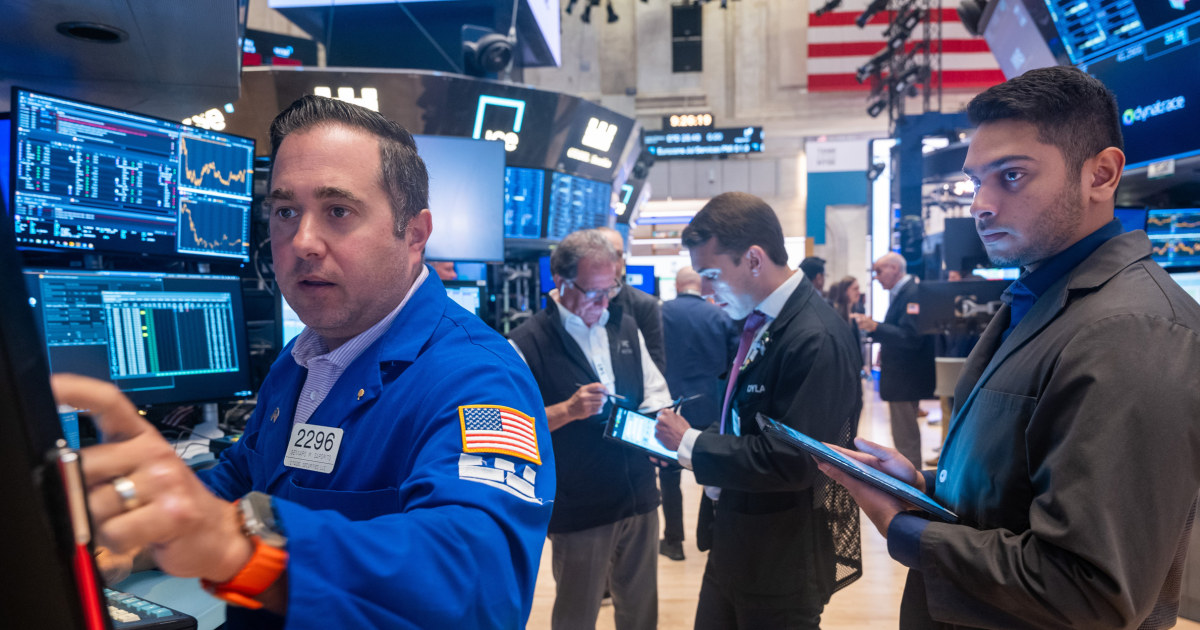Bussiness
Stock market live updates: U.S. stocks open lower amid economic uncertainty; Japan’s Nikkei index declines

Investing expert: “Rarely a profitable activity” for longterm investors to react to a big pullback
If you’re a regular investor, how should you react to today’s big sell-off?
For Steve Sosnick, chief strategist at Interactive Brokers financial group, the answer is: stoically.
In an email to NBC News, Sosnick said that while it is always healthy for everyday market participants to check in on how their holdings are performing, it does not make sense to react based on one, or even multiple, bad days.
“Reacting to panicky markets is rarely a profitable activity for long-term investors,” he said.
Still, drawdowns like today’s can be instructive.
“If a day like today is truly uncomfortable, then you’re carrying too much risk,” he wrote, noting today’s downdraft “hasn’t even been a 10% correction in the S&P 500 so far.”
“The index is still up 9% for the year-to-date,” Sosnick said. “That’s normally a great return! All we’ve done is given back the gains that we’ve made since the end of April. So if this downdraft is truly problematic for someone, they should consider more defensive investments.”
On the other hand, today does not necessarily represent a buying opportunity either, he said, noting everyone from Warren Buffett to the CEO of Nvidia, Jensen Huang, has recently sold some stock.
“Maybe it’s time to be a bit judicious, at least when it comes to reflexively buying the recent momentum leaders,” Sosnick said.
That idea was echoed by Bill Gross, a legendary investor known for his bond trades, who said he was neither buying nor selling.
When was the last emergency interest rate cut?
As the pandemic began hitting the United States, the Federal Reserve on March 15, 2020, cut interest rates to zero and immediately launched a $700 billion asset purchase program to sheild markets from its impact.
At the time, the Fed also cut rates for emergency lending to financial institutions to zero. Global markets were facing such severe disruptions from Covid that the Fed also coordinated its moves with the central banks of the United Kingdom, Canada, Japan, Switzerland and the European Central Bank, which oversees rates and monetary policy for 27 other countries.
Markets reacted sharply, with multiple rare marketwide trading halts pausing stocks throughout the day because the moves were so dramatic. On March 16, the Dow Jones Industrial Average dropped nearly 13%, and the S&P 500 and Nasdaq Composite plunged around 12%.
Trillion-dollar companies off worst levels of the day
Trading in some of the biggest companies in the world is rebounding after suffering significant losses earlier in the session.
Microsoft, Alphabet and Meta Platforms are now trading down less than 3%. Apple, the world’s most valuable company with a $3.2 trillion market value, is down around 4% after earlier falling as much as 12% at the start of the trading day. Amazon.com, which fell 10% earlier, is now trading lower by just about 4% as well.
GDP has been strong in 2024
One reason why some market commentators believe today’s sell-off is not a sign of newfound underlying economic weakness is that gross domestic product (GDP) measures have, so far, been stronger than expected this year.
The preliminary reading of the GDP for the second quarter, which encompasses April, May and June, came in at 2.8% — well ahead of forecasts.
The report had unmistakable signs of a slowdown, with the personal consumption expenditures price index — a key measure for the Federal Reserve — declining from 3.4% in Q1 to 2.6% in Q2.
But overall, GDP estimates continue to suggest a healthy economy: An unofficial real-time measure of growth published by the Atlanta Federal Reserve on Aug. 1 showed a measure of 2.5%.
#kamalacrash trends on X after Trump post
GOP presidential nominee Donald Trump sought today to turn the sell-off into a political issue, helping make #kamalacrash the No. 1 trending topic on X.
On his Truth Social account, Trump posted “KAMALA CRASH!” followed quickly by “KAMALA CRASH vs. TRUMP CASH!” around 11 a.m. ET.
Right-wing accounts on X including Libs of TikTok, RNC Research and End Wokeness were quick to follow as they attempted to portray the market drawdown as the result of Vice President Kamala Harris’ recent surge in polls.
It comes as X, owned by Trump supporter Elon Musk, has come under scrutiny for circulating false and misleading information in the run-up to November’s election. Today, officials from Minnesota, Pennsylvania, Michigan, New Mexico and Washington said X’s AI widget, Grok, misled users about ballot deadlines after President Joe Biden withdrew his re-election bid.
Trump’s running-mate, Ohio Sen. JD Vance, also published a post on Harris on X, writing, “This moment could set off a real economic calamity around the globe. It requires steady leadership–the kind President Trump delivered for four years. Kamala Harris is too afraid to answer media questions and cannot lead us in these troubled times.”
However, he added his own hashtag: “#WheresKamala.”
The S&P 500 has added about 36% during the Biden administration, with the Nasdaq up a little more than 20% and the Dow 25% higher since early 2021.
The Harris campaign declined to comment.
Schwab online trading services back after suffering issues
Charles Schwab said its online trading and portfolio platforms were fully operational again after earlier confirming that some clients were having trouble logging in.
Its platforms include the Schwab Trading service, Ameritrade and ThinkOrSwim.
Major indexes make up some ground at midday
Major U.S. stock indexes pared some losses as trading entered its midpoint of the day.
The Dow Jones Industrial Average was down less than 800 points, or just short of 2%, after falling as much as 1,100 points earlier in the day.
The S&P 500 was down 2.2% after declining more than 3% earlier.
And the tech-focused Nasdaq was off 2.6% after declining at much as 4.3% to start the day.
Stocks were bolstered following a business-services report that signaled the U.S. economy remained on firm footing.
Some analysts suggest markets are overreacting
With the sour market reaction seeding fears of a recession, some economists and market watchers are urging calm. (The economy is not currently in a recession, an assessment that the National Bureau of Economic Research would have to declare).
RSM US Economist Tuan Nguyen wrote Monday morning that his team is “cautious over the ‘panic’ recession calls over the weekend,” noting that economic fundamentals look “solid” for the time being.
“More importantly, we always advise against the overreactions to one month of data, especially after last week’s job data,” Nguyen noted.
ING Chief International Economist James Knightley similarly acknowledged that the July jobs report was “poor” but said the Institute for Supply Management (ISM) services report “suggests the situation looks ok with the economy growing.” He added that he does not expect the Fed to make an emergency interest rate cut before its next scheduled announcement on Sept. 18.
Others are suggesting market pricing on a more aggressive interest rate cut are wrong. EY Chief Economist Gregory Daco also pointed to the ISM figures as a reason to read the market bets on an aggressive Fed cut as an “overreaction.” Daco still expects to the Fed to cut by just 0.25% in September, an outlier view with markets now overwhelmingly expecting a 0.50% cut.
Role of “carry trade” in today’s sell-off under the microscope
While many laid blame for today’s market rout on macroeconomic fears about a U.S. recession, and possibly global recession, in the wake of a weaker-than-expected jobs report and subsequent concern about the Federal Reserve’s monetary policy stance, others saw a more direct culprit.
For some time, Wall Street has been plowing into a so-called “carry trade” that saw traders borrowing in Japanese yen, which had been subject to lower interest rates, in order to buy assets.
But in recent weeks, the Bank of Japan has signaled that its long-running practice of keeping interest rates low is coming to an end.
That has sparked a massive reversal in the value of the dollar against the yen, with the dollar now worth much less on a relative basis. It also helped tank Japanese stocks in trading today.
In an appearance Friday on CNBC, Cedric Chehab, global head of country risk at the firm BMI Research, said the carry trade had clearly “imploded” but that overall, a market reversal — especially at this time of year, was not surprising.
“Corrections like this are absolutely normal,” Chehab said.
Fidelity says issue resolved with online services
Fidelity Investments, which faced technical problems in early trading as customers tried to log in to trade or view their portfolios, now says the issue has been resolved.
Other platforms such as Charles Schwab and Vanguard also appear to be struggling, with both companies saying on X that they are working on restoring their sites.
Despite sell-off, stocks still holding onto 2024 gains
As of 10:45 a.m. ET, major stock indexes are still well in the green for the year. The Dow is up more than 2.7%, the S&P 500 is up more than 8.6% and the Nasdaq Composite is up more than 7.8% on the year.
And tracking returns over the last five years, the Dow has seen a jump of 50%, gains on the S&P 500 have been more than 82%, and the Nasdaq is up a whopping 109%.
Services data report surprises to upside; employment strong
Services data from the Institute for Supply Management (ISM), a business association that tracks economic activity among its members, came in better than expected this morning, taking some pressure off markets and bolstering hopes that the U.S. economy remains on sound footing.
The ISM’s headline services index hit 51.4%, signaling an expansion and besting forecasts for a reading of just 50.9%. Key industry contacts in the report described conditions as “strong,” “stable” or “steady.”
Employment activity indicated growth in July for just the second time in 2024, the ISM said, with the employment Index registered 51.1%. Industry contacts were quoted as saying: “Have many open requisitions to fill and personnel to train for the fall and 2025 ramp up” and “Higher productivity instead of replacing turnover.”
The report eased some of the bond-buying activity that had pushed the yield on the 10-year note to its lowest level in more than a year as investors flocked to safe-haven assets.
Every Dow stock in the red
With the Dow Jones Industrial Average currently seeing losses of more than 950 points, every single stock in the Dow is in the red. Intel and Amazon are among the worst hit. P&G and Coca-Cola are among the best performers, just slightly lower.
The Nasdaq 100 index has just two stocks in the green, ON Semiconductor and Advanced Micro Devices. But some major names such as chipmaker Arm Holdings, NVIDIA and Tesla are sharply lower.
On the S&P 500, cereal and snack food company Kellanova is up double digits as CNBC reports that rival food company Mars is in talks to acquire it. Tyson Foods, Arm and Hammer-owner Church & Dwight, Tractor Supply, Autozone and Clorox are some of the bright spots on the index. Casears, Etsy and Warner Bros. Discovery are some of the worst performers.

Online trading platforms Fidelity, Schwab facing technical problems
It’s just 30 minutes into the trading session, and online trading platforms Fidelity Investments and Charles Schwab say they are facing technical issues as users try to log in to trade and check their portfolios.
Fidelity, responding to user complaints on X, said it was aware “some customers may be experiencing issues logging in.”
Charles Schwab said it was “working to resolve the issue as quickly as possible” and warned that phone hold times “may be longer than usual.”
Computer chip stocks lead market lower amid fading artificial intelligence bets
Makers of computer chips were seeing the biggest sell-offs today, a signal that Wall Street is increasingly backing out of recent bets that the payoff from the artificial intelligence revolution would be imminent.
Nvidia, which had been powering much of the run-up in tech stocks thanks to its specialized chips, was down as much as 8% on the day, and is now off more than 21% over the last 30 days.
Rival Intel, which last week cratered 26% after a weak earnings report, was down as much as 10% and has lost 40% over the last 30 days. Super Micro Computer was down 7% and is off 31% since early July.
“AI tailwind has … begun to falter as investors have started to lose patience on monetization timelines,” Maxwell Grinacoff, a strategist at UBS financial group, wrote in a recent note to clients.
Pressure mounts on the Federal Reserve for a dramatic rate cut
The market spill has also juiced market bets on an aggressive interest rate cut from the Federal Reserve, which just last week opted not to change its policy rate but suggested an interest rate cut could come in its next scheduled policy announcement Sept. 18.
Following the Fed announcement, futures contracts traded at the CME Group implied a nearly 90% chance of a 0.25% interest rate cut, largely seen as the standard size for an interest rate adjustment.
After the lackluster July jobs report Friday, odds shifted quickly to a 75% chance of a 0.50% interest rate cut.
And with the global market rout and the spillover into this morning’s trading in the U.S., markets are now pricing in 8.5% odds that the Fed could even cut by an oversized 0.75%.
The Fed’s decision is key here because it controls the interest rates that determine much of the economy’s lending conditions, which in turn have a major impact on things such as mortgage rates and job creation.
The market action could jawbone the central bank into a larger interest rate cut than it seemed to suggest last week it was prepared to do.
“The immediate implication is that investors fear that the economy may weaken rapidly and want the Fed to cut rates aggressively to maintain economic growth,” Paul Christopher, head of global investment strategy at Wells Fargo Investment Institute, wrote in a note today.
In its meeting last Wednesday, Fed Chairman Jerome Powell said an improving outlook on inflation and a labor market in “better balance” meant the Fed was “getting closer to the point” of a rate cut but was “not quite at that point yet.”
Stocks plunge at the open of trading
As markets open, the Dow Jones Industrial Average plunged more than 1,100 points or 2.7%.
The broader S&P 500 fell 180 points or 3.3%, and the Nasdaq Composite tumbled 730 points or 4.3%.
The sharp drops seen by the the three major indexes at the open are fading a bit. The Dow is down about 1,000 points now, and the S&P 500 is down less than 2.9%. The Nasdaq, which tracks some of the biggest tech firms, is still facing the worst losses but has pulled back and is currently down less than 3.8%.
A weak jobs report triggered the Wall Street sell-off
The turmoil on Wall Street this morning began Friday on the heels of a weaker-than-expected jobs report. Government data showed employers added just 114,000 positions in July, down from 206,000 in June, and the unemployment rate ticked up to 4.3%.
That data added to a grab bag of economic signals stoking concerns that the U.S. economy is slowing down — from soft corporate earnings and weaker outlooks to global instability.
After the Friday jobs data showed the labor market cooling more sharply than anticipated, investors increasingly believe the Federal Reserve has waited too long to begin lowering interest rates.
By keeping rates elevated for the past year, the central bank has sought to tamp down demand across the economy to tame inflation. But a pullback in hiring has fanned fears that that medicine is now proving worse than the disease.
Are markets overreacting?
Beneath today’s scary sell-off numbers, evidence remains that the U.S. economy is still in good shape, though unquestionably slowing.
In a note to clients yesterday — to be sure, prior to this morning’s sell-off kicking off — Goldman Sachs economists said they don’t believe the weak jobs numbers for July are the new norm.
“We are hesitant to take the July jobs numbers as a new trend,” David Mericle and Maneul Abecasis wrote, adding: “Job growth will recover in August.”
They cited the still-low layoff rate, as well as demand for services holding up.
“Investors might be mistaking an inevitable deceleration for a recession,” they said.
And they dismissed the notion that the Federal Reserve must deliver a 50-point basis cut to its key interest rate at its next meeting in September, saying a a 25-basis point cut — the standard increment — would be sufficient.
“We continue to see recession risk as limited not only because the data look fine overall and we do not see major financial imbalances,” they wrote.
Chicago Fed President Goolsbee says if economy deteriorates, Fed will ‘fix it’
Chicago Federal Reserve President Austan Goolsbee today vowed that the central bank would react to signs of weakness in the economy and indicated that interest rates could be too restrictive now.
Asked whether weakening in the labor market and manufacturing sector could prompt a response from the Fed, he did not commit to a specific course of action but said it doesn’t make sense to keep a “restrictive” policy stance if the economy is weakening.
“The Fed’s job is very straightforward, maximize employment, stabilize prices and maintain financial stability. That’s what we’re going to do,” the central bank official said during an interview on CNBC’s “Squawk Box” program. “We’re forward-looking about it. So if the conditions collectively start coming in like that on the through line, there’s deterioration on any of those parts, we’re going to fix it.”
Dow futures down 1,200 points
The Dow Jones Industrial Average is set to open down some 1,200 points, or at least 3%. That’s something it hasn’t done since the drawdowns that kicked off market declines around the global Covid pandemic in March 2020.
Krugman: ‘Real case for an emergency cut soon.’
Paul Krugman, a Nobel Prize-winning economist and New York Times columnist, said today that market turmoil could create the need for an emergency Fed rate cut.
“So, even though I’ve been arguing for rate cuts — 50 in September for sure — I wasn’t calling for an inter-meeting cut, because that might signal panic,” he wrote on X. “But since we may be seeing a panic anyway, that argument loses its force. Real case for an emergency cut soon.”
Wall Street’s ‘fear gauge’ rises to highest level since 2020 pandemic market plunge
A key measure of expected volatility in the stock market surged to its highest level in more than four years this morning as global equities fell sharply.
The Cboe Volatility Index, or VIX, broke above 50 today, up from about 23 Friday and roughly 17 a week ago.
This is the highest the VIX has been since March 2020, shortly after the Federal Reserve’s emergency actions during the Covid pandemic, according to FactSet. The VIX rose as high as 85.47 in March 2020, according to FactSet.
Wharton economist calls for Fed to issue emergency rate cut
Jeremey Siegel, a professor emeritus of finance at the Wharton School of the University of Pennsylvania, today called on the Federal Reserve to make an emergency cut of 75 basis points in the federal funds rate after Friday’s disappointing jobs report.
In addition, there should be “another 75 basis point cut indicated for next month at the September meeting — and that’s minimum,” Siegel said on “Squawk Box” this morning.
“The Fed funds rate right now should be somewhere between 3.5 and 4%,” he said.
The Federal Reserve kept interest rates at 5.25% and 5.5% after its meeting last week. On Friday, the jobs report showed slower growth than expected and an unemployment rate that moved higher to 4.3%, its highest since October 2021.
Crypto market hit hard
It’s not just stocks. The crypto market is also reeling.
Bitcoin, which had already been on the downswing, has declined about 17% in the last 24 hours. It’s now down about 28% in the past week, according to the crypto platform Coinbase.
Japan’s Nikkei stock index drops 12%
Japan’s Nikkei Index, which tracks 225 public companies, dropped more than 12% today. It’s the worst decline since 1987’s “Black Monday,” which is one of the worst global stock market crashes on record.
The Nikkei also erased all its gains so far this year, moving into a loss position year to date.
The broad-based Topix also saw a rout as it tumbled 12.23% and closed at 2,227.15.
American recession fears spark huge Japan sell-off, point to lower U.S. open
U.S. stocks are on course to open in the red today, with Japanese stocks suffering their worst day of trading since the 1980s and a global equities sell-off intensifying over fears of a U.S. economic slowdown.
In premarket futures trading, the Dow Jones Industrial Average dropped by 1.4%, the S&P 500 was down 2.2% and the tech-stocks-heavy Nasdaq was set to slide by 3.5% at the open.














